Prime Your Lawn this Fall!
Fall is the best time to start transitioning your lawn to organic. The key to a healthy lawn is healthy soil and good mowing, watering and fertilizing practices. Healthy soil contains high organic content and is teeming with biological life. Healthy soil supports the development of healthy grass that is naturally resistant to weeds and pests. In a healthy, fertile and well maintained lawn, diseases and pest problems are rare.
 |
| How you treat your lawn is how you treat the environment! Learn about the importance of maintaining a delicate balance from our factsheet. |
If your lawn is currently chemically-dependent, initially it may be more expensive to restore the biological life. But, in the long term, it will actually cost you less money. Once established, an organic lawn uses fewer materials, such as water and fertilizers, and requires less labor for mowing and maintenance. More importantly, your lawn will be safe for children, pets and your local drinking water supply.
Getting Started
- Mow High Until the Season Ends – Bad mowing practices cause more problems than any other cultural practice. Mowing with a dull blade makes the turf susceptible to disease and mowing too close invites sunlight in for weeds to take hold.
Keep your blades sharp, or ask your service provider to sharpen their blades frequently. For the last and first mowing, mow down to 2 inches to prevent fungal problems. For the rest of the year keep it at 3-3.5 inches to shade out weeds and foster deep, drought-resistant roots. - Aerate – Compaction is an invitation for weeds. If your lawn is hard, compacted, and full of weeds or bare spots, aerate to help air, water and fertilizer to enter. If you can’t stick a screwdriver easily into your soil, it is too compacted. Get together with your neighbors and rent an aerator. Once you have an established, healthy lawn, worms and birds pecking at your soil will aerate it for free!
- Fertilize, but go easy! – Fertilizing in early fall ensures good growth and root development for your grass. Nitrogen, the most abundant nutrient in lawn fertilizers promotes color and growth. Adding too much nitrogen, or quick release synthetic fertilizers, will result in quicker growth and the need for more mowing. Too much nitrogen can also weaken the grass, alter the pH, and promote disease, insect, and thatch build-up. If applied too late, nutrients can leach directly into nearby surface waters. Be aware of local phosphorus or nitrogen loading concerns.
Your grass clippings contain 58% of the nitrogen added from fertilizers, improve soil conditions, suppress disease, and reduce thatch and crabgrass. So, leave the clippings on your lawn. You can also use a mulching mower and leave the leaves on the lawn too - a great alternative to raking.
Compost is an ideal soil amendment, adding the much-needed organic content to your soil and suppressing many turf pathogens. In the fall and spring, preferably after aerating, spread ¼ inch layer of organic or naturally-based compost over your lawn. Compost tea and worm castings are also great additions. Learn more from our factsheet, Compost is Key to Successful Plant Management.
It is highly recommended that you analyze your soil to determine specific soil needs. Contact your University extension service to find out how to take and send in a soil sample. In addition to nutrients and pH, ask for organic content analysis, and request organic care recommendations. Ideal pH should be between 6.5-7.0, and organic content should be 5% or higher. Your soil test results will ensure that you apply only what you need. Read Maintaining a Delicate Balance: Eliminating phosphorus contamination with organic soil management for in-depth information on the problem of fertilizer contamination, and how to apply fertlizer properly. - Overseed With the Right Grass Seed – Once again, fall is the best time to seed your lawn. Grass varieties differ enormously in their resistance to certain pests, tolerance to climatic conditions, growth habit and appearance. Endophytic grass seed provides natural protection against some insects and fungal diseases - major benefits for managing a lawn organically. Talk to your local nursery about the best seed for your area. Check to see the weed content of the grass seed and that there are no pesticide coatings.
- Develop Your Tolerance – Many plants that are considered weeds in a lawn have beneficial qualities. Learn to read your “weeds” for what they indicate about your soil conditions. Monocrops do not grow in nature and diversity is a good thing. See more information on our Least Toxic Control of Weeds factsheet.
For instance, clover- considered a typical weed, is found in soil with low nitrogen levels, compaction issues, and drought stress - conditions that can be alleviated with the above recommendations. However, clover is a beneficial plant that takes free nitrogen from the atmosphere and distributes it to the grass, which helps it grow. Clover roots are extensive and extremely drought resistant, providing significant resources to soil organisms, and staying green long after turf goes naturally dormant.








